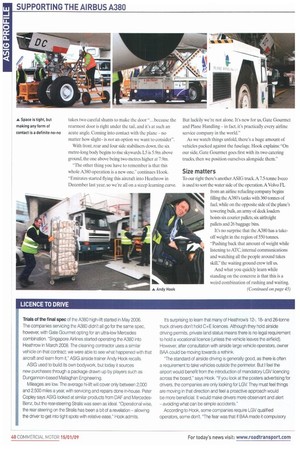LICENCE TO DRIVE
Page 40

Page 41

If you've noticed an error in this article please click here to report it so we can fix it.
Trials of the final spec of the A380 high-lift started in May 2006. The companies servicing the A380 didn't all go for the same spec, however, with Gate Gourmet opting for an ultra-low Mercedes combination. "Singapore Airlines started operating the A380 into Heathrow in March 2008. The cleaning contractor uses a similar vehicle on that contract, we were able to see what happened with that aircraft and learn from it," ASIG airside trainer Andy Hook recalls.
ASIG used to build its own bodywork, but today it sources new purchases through a package drawn up by players such as Dungannon-based Mallaghan Engineering.
Mileages are low. The average hi-lift will cover only between 2,000 and 2,500 miles a year, with servicing and repairs done in-house. Peter Copley says ASIG looked at similar products from DAF and MercedesBenz, but the rear-steering Stralis was seen as ideal. "Operational wise, the rear steering on the Stralis has been a bit of a revelation allowing the driver to get into tight spots with relative ease," Hook admits. It's surprising to learn that many of Heathrow's 12-, 18and 26-tonne truck drivers don't hold C+E licences. Although they hold airside driving permits, private land status means there is no legal requirement to hold a vocational licence (unless the vehicle leaves the airfield). However, after consultation with airside large vehicle operators, owner BAA could be moving towards a rethink.
"The standard of airside driving is generally good, as there is often a requirement to take vehicles outside the perimeter. But I feel the airport would benefit from the introduction of mandatory LGV licencing across the board," says Hook. "If you look at the posters advertising for drivers, the companies are only looking for LGV. They must feel things are moving in that direction and feel a proactive approach would be more beneficial. It would make drivers more observant and alert avoiding what can be simple accidents."
According to Hook, some companies require LGV qualified operators, some don't "The fear was that if BAA made it compulsory without a lengthy advance warning, the airport would grind to a halt."
As with the aircraft, ASIG's priority is more slanted towards the operation of the bodywork rather than the truck itself.
"It's normally a quick process for people to get used to the height and width of a rigid vehicle running round the roads and lanes of the airport." he explains.
But the part of the vehicle that could (potentially) cause the most damage is the bodywork both maneuvering around the aircraft and when it's in the air, against it.
"This is why our training is more about the controls associated with it," Hook states.
"We also focus on height restrictions and speed limits. The rules of the airport are different to those found on the other side of the fence," he concludes.




















































































































































